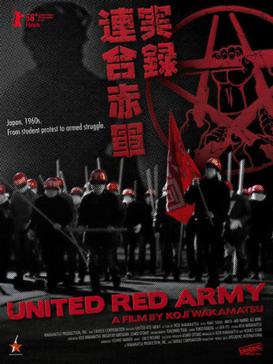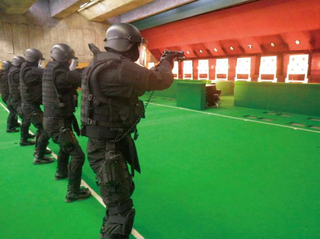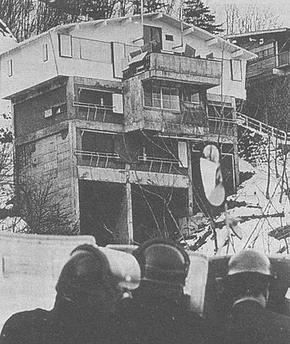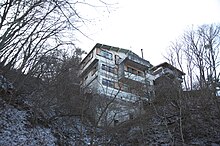The Japanese Red Army was a militant communist organization active from 1971 to 2001. It was designated a terrorist organization by Japan and the United States. The JRA was founded by Fusako Shigenobu and Tsuyoshi Okudaira in February 1971, and was most active in the 1970s and 1980s, operating mostly out of Lebanon with PFLP collaboration and funding from Muammar Gaddafi's Libya, as well as Syria and North Korea.

Karuizawa is a resort town located in Nagano Prefecture, Japan. As of 1 October 2016, the town had an estimated population of 20,323 in 9897 households, and a population density of 130 persons per km2. The total area of the town is 156.03 km2 (60.24 sq mi). Karuizawa, one of the oldest and most famous summer resorts in Japan, has been visited by many people from around the world since the 19th century.

Keiji Muto is a Japanese retired professional wrestler and professional wrestling executive. He is known for his work as The Great Muta in World Championship Wrestling (WCW) and New Japan Pro-Wrestling (NJPW) during the 1980s and 1990s, and from his runs in other Japanese, American, Puerto Rican, and Mexican promotions. He was the president of All Japan Pro Wrestling (AJPW) from 2002 to 2013 and representative director of Wrestle-1 (W-1) from 2013 to 2020.

Japan Air Lines Flight 472 was an aircraft hijacking carried out by the Japanese Red Army (JRA) on 28 September 1977.
During the interwar period in Japan, "incident" became a common euphemism for wars, coups, and other events of a politically sensitive or sensational nature. Using "incident" rather than more specific terms allowed Japanese journalists to maintain the appearance of neutrality while avoiding potential censorship. Prominent examples include the "Manchurian Incident", the "China Incident", and the "Nanjing Incident".

The Kudo-kai is a yakuza group headquartered in Kitakyushu, Fukuoka on the Kyushu island of Japan, with an estimated 200 active members. The Kudo-kai has been a purely independent syndicate ever since its foundation, and has caused numerous conflicts with the Yamaguchi-gumi.
Kim Hyi-ro was a second-generation Korean in Japan born in November 1928 in Shimizu, Shizuoka, who held 18 Japanese citizens hostage in 1968.
The AIA Building hostage crisis took place at the AIA Building in Jalan Ampang, Kuala Lumpur, Malaysia on 5 August 1975. The Japanese Red Army took more than 50 hostages at the AIA building, which housed several embassies. The hostages included the United States consul and the Swedish chargé d'affaires. The gunmen won the release of five imprisoned terrorists and flew with them to Libya.

Japan Air Lines Flight 351 was a scheduled passenger flight from Tokyo Haneda Airport to Fukuoka that was hijacked by members of the Red Army Faction of the Japan Communist League on March 31, 1970, in an incident usually referred to in Japanese as the Yodogo Hijacking Incident.

Tetsu Nakamura, also known as Kaka Murad, , was a Japanese physician and honorary Afghan citizen who headed Peace Japan Medical Services (PMS), an aid group known as Peshawar-kai in Japanese.
The United Red Army was a militant organization that operated in Japan between July 1971 and March 1972. The URA was formed as the result of a merger that began on 13 July 1971 between two extremist groups, the Marxist–Leninist–Maoist Red Army Faction, led in 1971 by Tsuneo Mori, and the Reformed Marxist Revolutionary Left Wing group, Japanese Communist Party Kanagawa Prefecture Committee, also known as the Keihin Anti-Security Treaty Joint Struggle Group, led by Hiroko Nagata.

Hiroko Nagata, sometimes mistakenly referred to as Yōko Nagata, was a Japanese leftist revolutionary and terrorist who was convicted of murder and sentenced to death. She was convicted of murdering, or participating in the murders of, fellow members of the United Red Army (URA) during a group purge in Gunma Prefecture in February 1972.
Fusako Shigenobu is a Japanese communist activist, writer, and the founder and leader of the now-disbanded militant group Japanese Red Army (JRA).
Tsuneo Mori was a Japanese radical leftist and terrorist. He was born in Osaka and entered the Osaka City University where he became involved in leftist politics, eventually joining the Red Army Faction, which was a schismatic militant subfaction of the Japan Communist League. After many members of the Red Army Faction were arrested by the Japanese police with Mori remaining at large, several members of the group went to North Korea with Japan Airlines Flight 351 and some formed the Japanese Red Army. Mori remained in Japan and eventually became the leader of the United Red Army. Along with Hiroko Nagata, he allegedly killed 12 members and he was arrested in February 1972. He committed suicide by hanging in his cell in Tokyo on January 1, 1973.

United Red Army is a 2007 film written, directed and produced by Kōji Wakamatsu. It stars Akie Namiki as Hiroko Nagata and Go Jibiki as Tsuneo Mori, the leaders of Japan's leftist paramilitary group, the United Red Army. Akie Namiki was nominated for Best Performance by an Actress at the 2008 Asia Pacific Screen Awards.
The East Asia Anti-Japan Armed Front was a Japanese New Left terrorist organization that existed from 1972 to 1975.
The New Left in Japan refers to a diverse array of 1960s Japanese leftist movements that, like their counterparts in the Western New Left, adopted a more radical political stance compared to the established "Old Left," which in the case of Japan was emblematized by the Japanese Communist Party and Japan Socialist Party. After emerging in the lead-up to the 1960 Anpo protests against the U.S.-Japan Security Treaty, the movement grew and diversified before climaxing with the Zenkyōtō movement which barricaded dozens of Japanese universities in 1968–1969. Much like its counterparts in the West, in the 1970s, the Japanese New Left became known for violent internal splits and terrorism, which caused the movement's influence to wane.
Events in the year 1972 in Japan. It corresponds to Shōwa 47 (昭和47年) in the Japanese calendar.

Riot Police Unit are the rapid reaction forces of Japanese prefectural police. These units are not only riot police, but a type of emergency service unit to maintain public order against large civil disorder, disaster response, or other emergency situations as the key units of Japanese law enforcement for crisis management. They are operated by prefectural police headquarters (PPH) under the supervision of the Security Bureau of the National Police Agency.

Special Investigation Teams (SIT) are tactical detective units of Japanese prefectural police forces. Special Investigation Teams are maintained by prefectural police headquarters (PPH) and are trained to handle critical incidents including criminal investigation and tactical operations.













